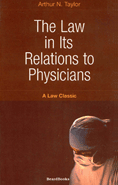|
|
|
|
||||||

|
The Law in Its Relations to Physicians
By Arthur N. Taylor 
1999/11 - Beard Books - Medical Classic 1893122271 - Paperback - Reprint - 560 pp. US$34.95 A ready reference for physicians on their legal rights and responsibilities arising frequently in their practice. Publisher Comments
This book was intended to be a ready reference for physicians on their legal rights and responsibilities on matters that arise frequently in their practice. It sets forth the relation between various questions of law and the reasons upon which their solutions are based. Thus, the design is to lend an understanding of the general principles upon which rights are based so that as unexpected emergencies arise the physician can determine the rights and accountabilities of the interested parties involved. Review by Henry Berry, The law as it pertains to the practice of medicine is complex, but the author makes it more comprehensible through an outstanding organization of the subject matter. It is this organization that makes Taylor’s work, first published in 1900, timeless and an ideal reference today for physicians as they provide healthcare. The book is also suitable as a text for a course or selfstudy on the intersection of the law and medical practice. Although the delivery of healthcare has grown increasingly complex and the technology used to provide that care is now highly sophisticated, The Law and Its Relation to Physicians remains relevant because at its core are a set of legal principles upon which all medical practice is based. These principles are reasonable and easily grasped. An attorney with broad and lengthy experience in different fields, Taylor understands that physicians have a different take on the law than do lawyers. Unlike lawyers, doctors are not interested in defending clients or winning lawsuits; nor do doctors presume to offer legal advice or guidance for other doctors. Doctors are primarily concerned with preventing lawsuits in the first place. Taylor conveys the purpose of his book as follows: “[t]he object of this work is to place within the reach of every physician a systematic treatment of those questions of law which present themselves most frequently in his professional work.” Taylor also notes that, when physicians are educated about their legal rights, they deliver healthcare more confidently and securely and, in the event of a malpractice suit, can contribute to their defense. The content is largely concerned with informing the reader how to guard against malpractice, whether by commission or omission. Some attention is given to acts by doctors that could be regarded as criminal acts. As rare as such acts are, this is nevertheless a relevant subject for readers. The crimes Taylor covers are not the obvious ones, such as illegally selling drugs or defrauding insurance companies. Instead he focuses on medical care that is alleged to have caused serious injury or even death to a patient and thus exposes the physician to criminal liability. The cases where a physician becomes subject to criminal liability usually fall within the category of “gross ignorance” or “reckless negligence.” Whether a physician is civilly liable or criminally liable depends on his or her intent. However, in cases of gross ignorance or reckless negligence, the physician’s explanation or demonstration of intent is not a defense against criminal accusations. For, says Taylor, “if the ignorance or neglect is gross, then the criminal intent will be implied.” In keeping with his purpose of guiding doctors, not lawyers, the author does not belabor points of law or engage in lengthy legal discussions and judicial rulings, as is common in many law texts. When Taylor occasionally quotes from a ruling or legal commentary, it is to illustrate a specific point. Mostly, however, he paraphrases in plain language or he condenses or summarizes the law on topics of specific concern to physicians. Taylor focuses on cases that have especially influenced case law. Legal references citing case name and so forth are provided for all cases referred to in the text. Taylor begins his work by setting forth the rights of a trained, qualified individual – in other words, the physician – to practice medicine and surgery. This is followed by chapters on the foundation of every doctor-patient relationship: the contract of the physician with the patient and vice versa. In civil cases of medical malpractice, a violation of this contract foundation is nearly always at issue. The large majority of these civil cases are based on alleged negligence by a patient regarding treatment by a doctor. There are other grounds for a lawsuit against a doctor, however. For example, a lawsuit may be filed by an interested third-party for failure to respect privileged communication between patient and doctor. A typical third party is a parent of a child under a doctor’s care. A husband and wife are also recognized third parties in the case where one or the other is incapacitated. Taylor deals with these and a multitude of other legal requirements arising from the doctor-patient relationship. The utility of Taylor’s work lies in its simplicity of
organization and comprehensiveness of content. The author’s
thorough understanding of medical law and his skillful writing ability
have produced an exemplary handbook for physicians who must be as
knowledgeable about the law as they are about their chosen profession.
|
|
|
|
home
| about us
| contact us
| related
sites |